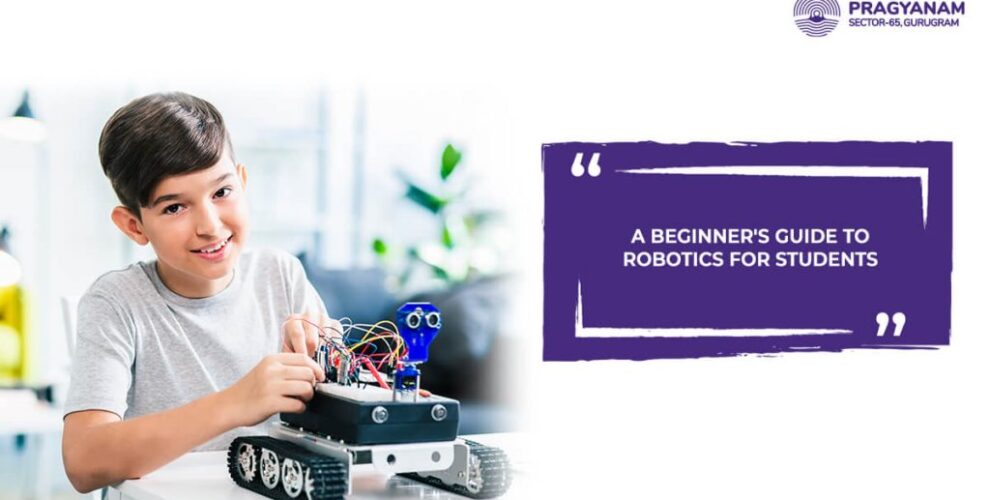Welcome to the fascinating world of robotics! In today’s technologically advanced era, it has become an integral part of our lives. From autonomous cars to robotic surgery, the applications of robotics are endless. However, it’s not just limited to complex industries or research labs; robotics can also be a fun and educational tool for school students. In this blog post, we will explore the exciting world of it and how it can benefit school students. We will dive into the basics of Automation, its relevance in today’s world, and the numerous skills it can help develop in students.
At Pragyanam, one of the best CBSE schools in Gurgaon, our focus is on the holistic development of children. So, if you are curious about robots and how they work, or if you are a parent or an educator interested in introducing robotics to young minds, this blog post is for you!
Table of Contents
The Basics of Robotics
Robotics is a field of study that combines engineering, computer science, and technology to design, build, and program robots. It is a fascinating and rapidly growing field that has the potential to revolutionize various industries. For school students, it can serve as an excellent introduction to the world of science, technology, engineering, and mathematics (STEM).
In its simplest form, a robot is a machine that can perform tasks autonomously or with minimal human intervention. It can be programmed to perform specific actions or respond to its environment using sensors and actuators. It involves understanding the principles of mechanics, electronics, and programming to create intelligent machines that can mimic human actions.
What is Robotics for Children
Robotics for children is an educational approach that introduces young learners to the principles of robotics and encourages them to explore, experiment, and solve problems using robots. It is a hands-on, interactive learning experience that promotes creativity, critical thinking, and team collaboration.
By incorporating robotics into STEM education, schools can provide students with a holistic learning experience that combines theory with practical application. it helps students develop important skills such as problem-solving, logical reasoning, and analytical thinking. It also nurtures their creativity, as they are required to innovate and find unique solutions to challenges.
Benefits of Introducing it to School Students
Introducing robotics to school students offers numerous benefits that go beyond just learning about technology. Here are some key advantages.
1. Enhances STEM Skills: Robotics integrates science, technology, engineering, and mathematics, allowing students to develop a strong foundation in these subjects. It fosters a deeper understanding of scientific concepts and encourages students to apply their knowledge in real-world scenarios.
2. Promotes Critical Thinking: It requires students to think critically and analytically. They must identify problems, analyze data, and devise solutions. These skills are transferable and can be applied to various academic and professional settings.
3. Encourages Creativity: Automation provides a platform for students to explore their creativity. They can design and build their robots, customize their functionalities, and find innovative ways to solve problems. This promotes out-of-the-box thinking and nurtures their imagination.
4. Develops Collaboration and Communication Skills: Robotics often involves teamwork, where students must collaborate, communicate, and delegate tasks. This enhances their ability to work effectively in groups, listen to others’ ideas, and express their thoughts clearly.
5. Prepares for the Future: With automation and artificial intelligence becoming increasingly prevalent, robotics education equips students with the skills required for the future job market. It prepares them for careers in fields such as robotics engineering, automation, and artificial intelligence.
Robotics Curriculum
A well-designed robotics curriculum should be age-appropriate, progressive, and aligned with educational standards. It should include a combination of theoretical concepts, hands-on activities, and guided projects. The curriculum should introduce students to the basics of robotics, including the different components of a robot, programming languages, and sensors.
As students progress, the curriculum can delve into more advanced topics, such as robot design, motion planning, and artificial intelligence. It should incorporate challenges and competitions that encourage students to apply their knowledge and compete with their peers.
Robotics Courses for Students
Various organizations and institutions offer robotics courses specifically designed for school students. These courses range from introductory workshops to comprehensive programs that span several months. They provide students with a structured learning environment where they can explore robotics and develop their skills.
Robotics courses often include hands-on activities, programming exercises, and project-based learning. They may also provide access to robotics kits and software tools that enable students to build and program their robots.
Examples of Robotics in Education
Robotics has gained significant traction in educational settings, with schools and institutions worldwide embracing its potential. Here are a few examples of how robotics is being integrated into education
1. Robotics Competitions: Schools organize competitions where students design and build robots to complete specific tasks or challenges. These competitions foster teamwork, problem-solving, and creativity.
2. Robotics Clubs: Many schools have robotics clubs where students can explore it in a less formal setting. These clubs provide a platform for students to collaborate, learn from each other, and work on exciting projects.
3. Coding and Robotics Classes: Schools offer coding and robotics classes as part of their curriculum or as extracurricular activities. These classes introduce students to programming concepts and allow them to apply their knowledge to control robots.
4. STEM Camps: During summer or school breaks, STEM camps often include robotics as one of the activities. These camps provide an immersive learning experience where students can engage in hands-on robotics projects and experiments.
Conclusion
Robotics education offers students a unique opportunity to explore the fascinating world of technology, engineering, and programming. By introducing it in schools, we can cultivate a generation of creative problem solvers, critical thinkers, and innovators who are well-prepared for the future.
Through automation, students develop essential skills such as collaboration, communication, and critical thinking. They gain a deep understanding of STEM subjects and acquire practical knowledge that can be applied in various domains. Moreover, robotics education nurtures curiosity, ignites a passion for learning, and opens doors to exciting career opportunities.
In conclusion, embracing robotics education is not only about preparing students for the future but also about empowering them to become active contributors to society. By providing them with the tools, knowledge, and experiences they need, we can inspire the next generation of inventors, scientists, and engineers who will shape the world. So, let us embrace the fascinating world of robotics and embark on this transformative educational journey.







Leave a Reply